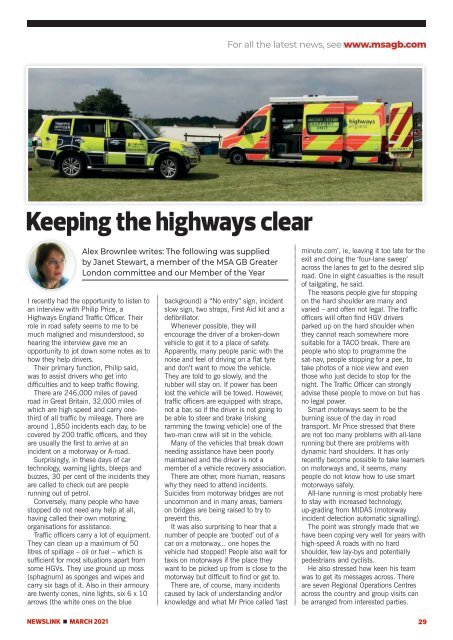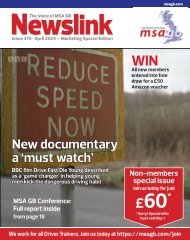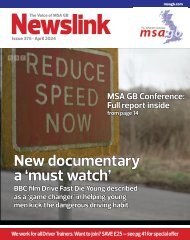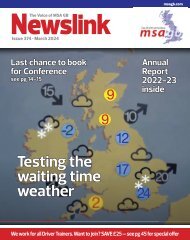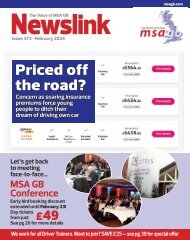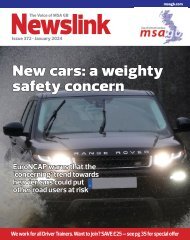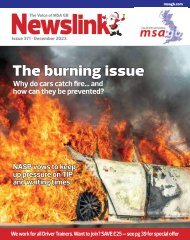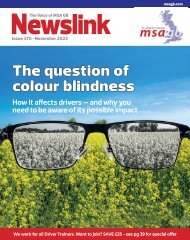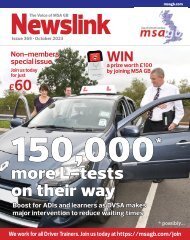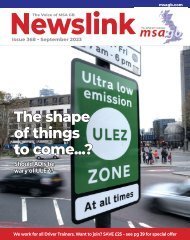Newslink March 2021
Motor Schools Association of Great Britain membership magazine; driver training and testing; road safety; general motoring matters
Motor Schools Association of Great Britain membership magazine; driver training and testing; road safety; general motoring matters
You also want an ePaper? Increase the reach of your titles
YUMPU automatically turns print PDFs into web optimized ePapers that Google loves.
For all the latest news, see www.msagb.com<br />
Keeping the highways clear<br />
I recently had the opportunity to listen to<br />
an interview with Philip Price, a<br />
Highways England Traffic Officer. Their<br />
role in road safety seems to me to be<br />
much maligned and misunderstood, so<br />
hearing the interview gave me an<br />
opportunity to jot down some notes as to<br />
how they help drivers.<br />
Their primary function, Philip said,<br />
was to assist drivers who get into<br />
difficulties and to keep traffic flowing.<br />
There are 246,000 miles of paved<br />
road in Great Britain, 32,000 miles of<br />
which are high speed and carry onethird<br />
of all traffic by mileage. There are<br />
around 1,850 incidents each day, to be<br />
covered by 200 traffic officers, and they<br />
are usually the first to arrive at an<br />
incident on a motorway or A-road.<br />
Surprisingly, in these days of car<br />
technology, warning lights, bleeps and<br />
buzzes, 30 per cent of the incidents they<br />
are called to check out are people<br />
running out of petrol.<br />
Conversely, many people who have<br />
stopped do not need any help at all,<br />
having called their own motoring<br />
organisations for assistance.<br />
Traffic officers carry a lot of equipment.<br />
They can clean up a maximum of 50<br />
litres of spillage – oil or fuel – which is<br />
sufficient for most situations apart from<br />
some HGVs. They use ground up moss<br />
(sphagnum) as sponges and wipes and<br />
carry six bags of it. Also in their armoury<br />
are twenty cones, nine lights, six 6 x 10<br />
arrows (the white ones on the blue<br />
NEWSLINK n MARCH <strong>2021</strong><br />
Alex Brownlee writes: The following was supplied<br />
by Janet Stewart, a member of the MSA GB Greater<br />
London committee and our Member of the Year<br />
background) a “No entry” sign, incident<br />
slow sign, two straps, First Aid kit and a<br />
defibrillator.<br />
Whenever possible, they will<br />
encourage the driver of a broken-down<br />
vehicle to get it to a place of safety.<br />
Apparently, many people panic with the<br />
noise and feel of driving on a flat tyre<br />
and don’t want to move the vehicle.<br />
They are told to go slowly, and the<br />
rubber will stay on. If power has been<br />
lost the vehicle will be towed. However,<br />
traffic officers are equipped with straps,<br />
not a bar, so if the driver is not going to<br />
be able to steer and brake (risking<br />
ramming the towing vehicle) one of the<br />
two-man crew will sit in the vehicle.<br />
Many of the vehicles that break down<br />
needing assistance have been poorly<br />
maintained and the driver is not a<br />
member of a vehicle recovery association.<br />
There are other, more human, reasons<br />
why they need to attend incidents.<br />
Suicides from motorway bridges are not<br />
uncommon and in many areas, barriers<br />
on bridges are being raised to try to<br />
prevent this.<br />
It was also surprising to hear that a<br />
number of people are ‘booted’ out of a<br />
car on a motorway... one hopes the<br />
vehicle had stopped! People also wait for<br />
taxis on motorways if the place they<br />
want to be picked up from is close to the<br />
motorway but difficult to find or get to.<br />
There are, of course, many incidents<br />
caused by lack of understanding and/or<br />
knowledge and what Mr Price called ‘last<br />
minute.com’, ie, leaving it too late for the<br />
exit and doing the ‘four-lane sweep’<br />
across the lanes to get to the desired slip<br />
road. One in eight casualties is the result<br />
of tailgating, he said.<br />
The reasons people give for stopping<br />
on the hard shoulder are many and<br />
varied – and often not legal. The traffic<br />
officers will often find HGV drivers<br />
parked up on the hard shoulder when<br />
they cannot reach somewhere more<br />
suitable for a TACO break. There are<br />
people who stop to programme the<br />
sat-nav, people stopping for a pee, to<br />
take photos of a nice view and even<br />
those who just decide to stop for the<br />
night. The Traffic Officer can strongly<br />
advise these people to move on but has<br />
no legal power.<br />
Smart motorways seem to be the<br />
burning issue of the day in road<br />
transport. Mr Price stressed that there<br />
are not too many problems with all-lane<br />
running but there are problems with<br />
dynamic hard shoulders. It has only<br />
recently become possible to take learners<br />
on motorways and, it seems, many<br />
people do not know how to use smart<br />
motorways safely.<br />
All-lane running is most probably here<br />
to stay with increased technology,<br />
up-grading from MIDAS (motorway<br />
incident detection automatic signalling).<br />
The point was strongly made that we<br />
have been coping very well for years with<br />
high-speed A roads with no hard<br />
shoulder, few lay-bys and potentially<br />
pedestrians and cyclists.<br />
He also stressed how keen his team<br />
was to get its messages across. There<br />
are seven Regional Operations Centres<br />
across the country and group visits can<br />
be arranged from interested parties.<br />
29


